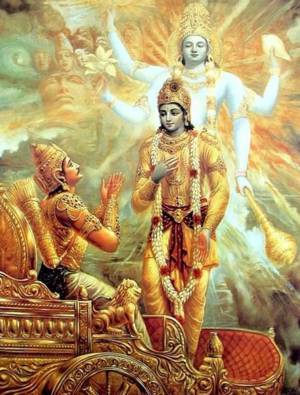Talk:Saguṇa Brahman as Antaryāmī:Interfaith Perspectives: Antaryāmī in other Religions
By Sri Vishal Agarwal
The distinction between the Hindu and the Abrahamic notions of an all-pervading and immanent Bhagavān may be explained with the following example: For Abrahamic religions, Bhagavān resides in the heaven but is present everywhere in the sense that he can control the entire Universe, and also knows what happens everywhere in the Universe. He is like a candle inside a room, with the candle representing Bhagavān, and the light of the candle spread out in the room reflecting Bhagavān’s omnipotence and omnipresence. In that sense, the Abrahamic Bhagavān is ‘contained’ within the heaven although he can control what is in the entire Universe.
There is no understanding of Bhagavān beyond the Universe. Therefore, Bhagavān transcends the Universe, but is not immanent to it. The Abrahamic religions have no conception of Bhagavān that is independent of space and time.
In contrast, in Hindu dharm, Brahman is not just present in heaven to govern the Universe by remote control. Brahman is present equally everywhere. He is not just transcendent to the Universe. He is also beyond it, and beyond all space and time. Rather than being a candle in a particular location that lights the area around it, Brahman is like an all-pervading inflammable gas, that is burning everywhere and all the time.
When Kṛṣṇa shows his ‘Viśvarūpa’ (Universal Form) to Arjuna (in Bhagavad Gītā, chapter 12), who was first bestowed with the divine eye, Arjuna saw a Divine Being with infinite faces, eyes, marvelous displays, adorned with divine clothes, garlands and ornaments. Arjuna saw that the splendor of this Being exceeded the light of a thousand suns shining simultaneously. Arjuna saw the entire Universe in that Being — the past, the present, the future. Arjuna was overwhelmed with what he saw. He bowed reverentially and said:
"O Bhagavān! I see within you Brahmā, the creator. I see Viṣṇu with his four arms. I see Śiva. I see the heaven, earth, all planets, stars, all living creatures, all Devas, countless things that I cannot even understand. Your radiance dazzles me. You have no beginning, no end, no middle. You are the Being who upholds dharm eternally, who is Infinite, Who is the Creator and the Destroyer. The worlds seem to tremble at your sight. You are the foundation of the entire Universe. I am terrified to see your mouths blazing with fire. I can see these countless warriors in the Kurukṣetra battlefield plunging to their deaths into your mouths, as moths plunge into a flame. The entire Universe is filled with your glory and is radiant with your light. This sight is so overwhelming that I am terrified. You are the Father, the Grandfather, the Teacher and the Mother of the entire Universe. Please treat me as a father would treat his son, or a friend his friend."
It is this nature of Brahman that explains his aspect of being the Antaryāmī. Brahman controls, oversees, governs the Universe and all the creatures in it not from a remote position in the heaven, but by being inside everything and by everything being inside Him.
Secondly, in the Hindu faith, as demonstrated by quotations from the Gītā and other scriptures above, the Bhagavān abides equally within not just humans but within all creatures. And therefore, people extend the concept of compassion and kindness to animals as well as to plants. Even though different species differ in their levels of consciousness and intelligence, they nevertheless have the same Divine Light within them. Eventually, all creatures can transmigrate and attain mokṣa. Numerous narratives illustrate this implication of seeing the Bhagavān within all creatures.
Seeing Brahman in Non-Humans: Sant Ekanātha Sees Rāma in a Donkey
Once, Sant Ekanātha was travelling from Vārāṇasī in north India towards Rāmeśvaram in south India with some water from the Gaṅgā river. It is to offer Gaṅgā water to the Śiva-liṅga at Rāmeśvaram. On their way, he and his disciples were travelling through an extremely hot and dry part of India.
Everyone wanted to quench their thirst but the only water was the Gaṅgā water they were carrying. No one wanted to drink it himself because it was meant for worship at Rāmeśvaram. Suddenly, Ekanātha saw a donkey lying on the ground, dying of thirst.
Ekanātha was filled with compassion. He immediately took his pitcher of the Gaṅgā water, and poured it into the mouth of the dying donkey. With its thirst quenched, the donkey revived.
Shocked at this act, a disciple asked Ekanātha, "Guruji, we have travelled hundreds of miles with this holy water to perform worship in Rāmeśvaram. Now where will we get the water of Gaṅgā for our worship of Rāmeśvaram’s Śiva now?"
Ekanātha replied, "This is my Rāmeśvara."
Ekanātha demonstrated through his deed that Bhagavān resides even in a donkey, and if we cannot treat animals with compassion, we cannot claim that we love Bhagavān.

